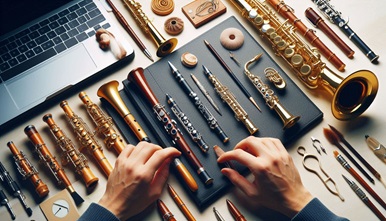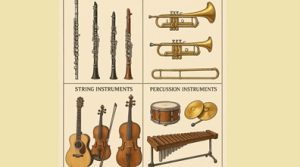Choosing the Right Woodwind Instruments: A Beginner’s Guide
Choosing the Right Woodwind Instruments: A Beginner’s Guide
Woodwind instruments have a long-standing presence in music, playing key roles in everything from classical symphonies to jazz ensembles.

If you’re considering picking up a woodwind instrument, you’re about to embark on a rewarding musical journey.
The woodwind group is prized for its expressiveness and versatility. From the deep, silky tones of the saxophone to the melodic, brilliant sounds of the flute, each has a distinctive personality and charm.
Easiest Woodwind Instruments
With so many options, choosing the right one can be overwhelming—yet with some advice, you can find the perfect one for your musical aspirations, personality, and body comfort.
Here on this blog article, we will be talking about the different types of woodwind instruments and helping guide you to make your decision.
You will learn which ones are appropriate for different genres of music, how hard they are to learn, and handy information like size, weight, and mobility.
Let’s continue and determine the best woodwind instrument for you!
What Is a Woodwind Instrument?
Woodwinds are a family of wind musical instruments that produce sound when air is blown across or into an opening.
Pitch is usually controlled by opening and closing along the instrument’s body, either directly with the fingers or with a system of keys.
Not all woodwind instruments are wooden, although their name implies that. Many of them are metal, such as the flute and saxophone.
What distinguishes woodwind instruments, however, is not the fact that they are made of wood, but how they produce their sounds.
Guide to Choosing a Woodwind Instrument: Easiest Woodwind Instruments to Learn
Choosing the right woodwind instrument is more than a matter of selecting one that sounds or looks pretty.
It’s important to consider the genre of music you enjoy, the difficulty level with the instrument, and logistics like size and playability.
Musical Style & Genre
Your musical taste can be helpful in the process. Different woodwind instruments are used within different genres:
- Flute – Standard within classical, folk, and world music
- Saxophone – Played in jazz, blues, rock, and pop
- Clarinet – Played in classical, jazz, and klezmer
- Oboe – Used frequently in classical, orchestral, and chamber music
Choosing an instrument that you enjoy playing will help you to remain excited to learn.
Difficulty Level
Wood instruments vary in the level of difficulty to learn and play. Your musical experience, breath control, and finger dexterity are involved.
Here’s a very rough idea:
- Easiest wind instrument to learn: Recorder – Typically taught as a first instrument due to its simple design and simplicity to play
- Moderate: Flute, Clarinet – Requires more control, but within reach for learners with practice
- Oboe, Bassoon – Identified by their unique reeds and difficult embouchure (mouth position)
Types of Woodwind Instruments
Let’s examine some better-known members of the woodwind group in more detail:
Recorder
The recorder has:
- Straight, cylindrical shape
- Whistle-like fipple mouthpiece
- Seven holes (six front, one back) for changing notes
It is especially common in early music, folk, and school settings.
Recorders come in several sizes (soprano, alto, tenor, bass) and materials, from plastic (perfect for beginners) to wood or ivory for serious players and collectors.
Flute
The flute is a slender, cylindrical instrument with a bright, sweet sound.
It’s usually thought of as one of the easier woodwind instruments for beginners, due to its simple fingering system and how easy it is to make sound by blowing across the mouthpiece opening.
- Types of music: Classical, folk, world music
- Reasons to choose it: Light, easy to learn, and played in many types of music
- Level of skill: Beginner through advanced
Piccolo
The piccolo is a small version of the flute—half to one third the size—and produces a brilliant, piercing sound that easily cuts through large ensembles.
Like the flute in playing technique, it is more demanding in control and accuracy because it is higher-pitched and smaller.
- Orchestral, military band, marching band
- Why Use It: Adds a spark of interest to ensemble playing; suitable for expressive, high-pitched music.
- Level of Skill: Intermediate-advanced
Clarinet
The clarinet is one instrument with an arm-rich tone, and a great range of dynamics.
It’s relatively simple for an upper elementary or middle school student to learn but needs practice to master breath and reed control for a clear consistent tone.
- Musical Styles: Classical, klezmer, jazz, marching bands
- Why Choose It: Extremely expressive and flexible; well-suited for solo and ensemble
- Skill Level: Beginner to expert
Saxophone
The saxophone is a conical single-reed instrument most renowned for its jazzy, soulful tone.
Although made of metal, it is thought of as a woodwind instrument because it produces sound from reeds.
It is an expressive, dynamic, and versatile instrument well suited to experimentation and improvisation.
- Musical Styles: Jazz, blues, rock, pop
- Why Choose It: Highly expressive, excellent for experimentalists and improvisers
- Skill Level: Beginner (alto/tenor) to advanced (baritone/soprano)
Oboe
The oboe is a moderately difficult woodwind because it has intricate fingerings and exacting breath control demands.
- Musical Styles: Classical, orchestral, chamber music
- Why Choose It: Excellent for blending in an ensemble and solo performance in the classical arena
- Skill Level: Intermediate to advanced
Bassoon
The bassoon is a double-reed instrument and produces a warm, rich, and deep voice.
It is large and possesses an elaborate system of keys, which can be difficult for beginners to handle, but it does produce a unique voice for the woodwinds.
Musical Style Types: Classical, orchestral, wind ensemble
Reasons to Choose: Used for low-register lines; adds depth and personality to ensemble playing
- \Skill Level: Intermediate to advanced
How to Buy a Good Second-Hand Woodwind Instrument
Great plan—just be cautious. Keep reading for some tried-and-tested advice to help you get the best instrument without breaking the bank later:
Where to Find One
- \Ask Friends and Relatives: Neighbors, relatives, or friends may have a clarinet or flute collecting dust since school times.
- Local Sales: Church bazaars, tag sales, and local bulletin boards are all great places to find hidden treasures that might have been overlooked.
- Classified Ads: Local newspapers and online communities like Facebook Marketplace or Craigslist are good places to try.
- Music Stores: Some stores will accept trade-in instruments or provide consignment with a warranty.
Pro Tip: Why? Because nearly all used instruments will need some kind of repair.
In some cases, it will be just a little bit of tweaking tuning. In others, it will be an overhaul that costs a lot of money.
A Note on eBay & Online Auction Sites
While websites like eBay may offer what seems to be a good deal, there are hazards:
- \You can’t inspect the instrument well.
- \Photos and descriptions are often vague or misleading.
- The instrument may arrive requiring significant repair, or not as described.
- Returns might be hard and sometimes impossible.
If you’re buying online, make sure the retailer allows returns and factor repair fees into your budget.
Most repair facilities, like Tim Moran Woodwinds LLC, even offer free inspections and estimates for possible purchases.
What Is the Easiest Woodwind Instrument to Learn?
If you’re a beginner looking for a friendly entry point into the world of woodwinds, the recorder is often the best place to start.
Why the Recorder?
- Simple Design: Its straight, cylindrical body and whistle-like mouthpiece (called a fipple) make sound production easy, even for complete beginners.
- Beginner-Friendly Fingering: The finger holes are intuitive and easy to cover, making it especially suitable for young learners and small hands.
- Rapid Learning Curve: Unlike many other woodwinds that require complex mouth alignment (embouchure), the recorder allows for a pleasing sound you can produce instantly.
- Cost-effective: Recorders are much less costly than most other woodwinds, ideal for budget-conscious families or schools.
- Lightweight & Portable: Easy to take around and best suited for school settings or group lessons.
Musical Versatility
By no means as straightforward as it appears, the recorder plays in many different styles of music, including:
- Early Music (Renaissance, Baroque)
- Folk Traditions
- Classical Ensembles
And here’s an elegant and engaging Conclusion to conclude your guide with clarity and encouragement:
Conclusion
Woodwind instruments introduce us to a world of musical possibility, each having its distinct voice and personality.
From the airy light tone of the flute to the dark, rich sounds of the bassoon, there’s something for every taste in the woodwind family.
As you browse, make sure to keep in mind:
- What type of music would you like to play
- The learning curve on each instrument
- The physical demands and comfort level of each instrument
Whether you’re a beginner or returning to music after a period of absence, there’s a woodwind instrument that suits your purposes, personality, and physical requirements.
Take your time, do your research, and follow your musical passion. With practice and patience, you’ll find yourself growing into a confident, expressive woodwind musician, ready to bring melodies to life.





